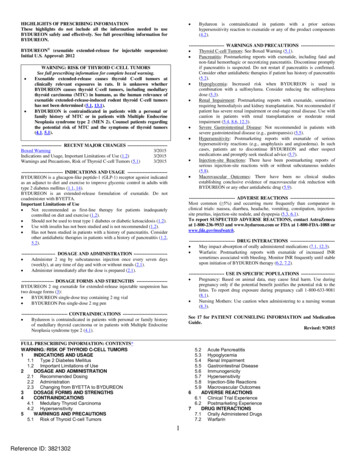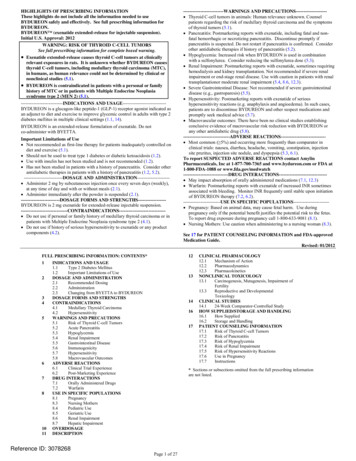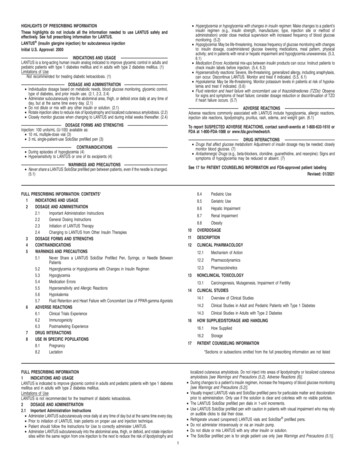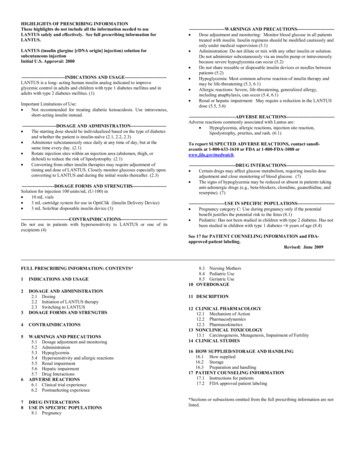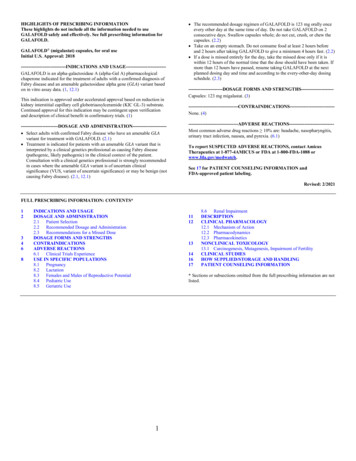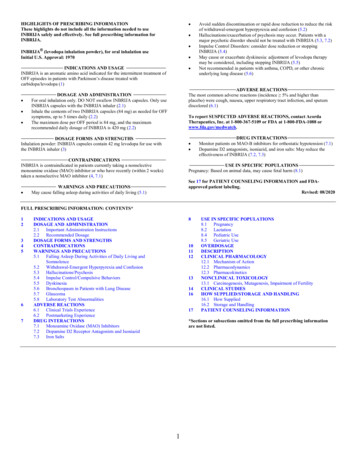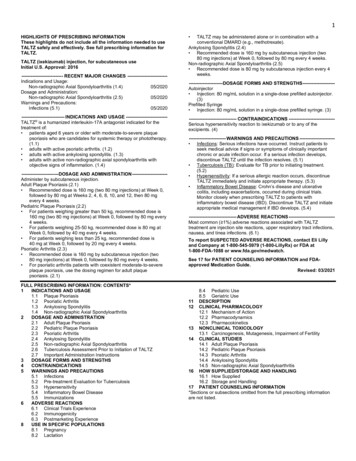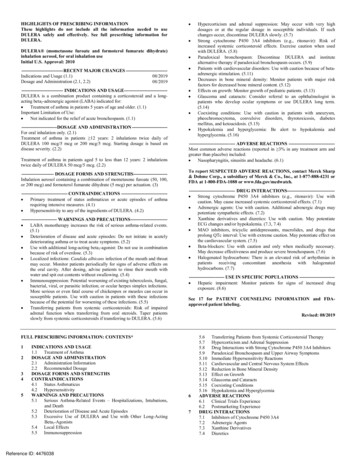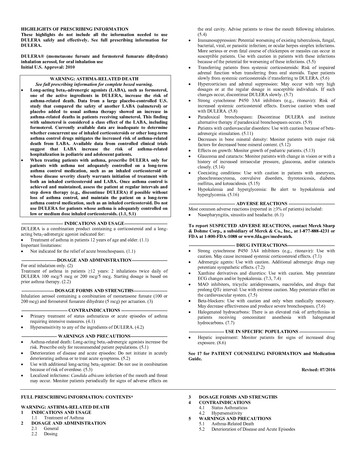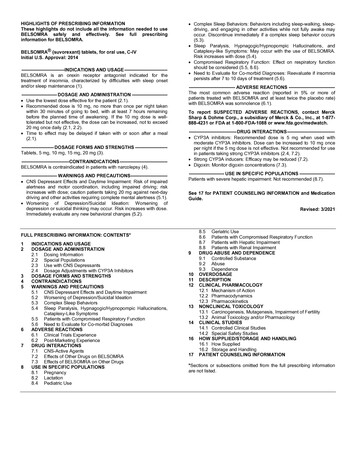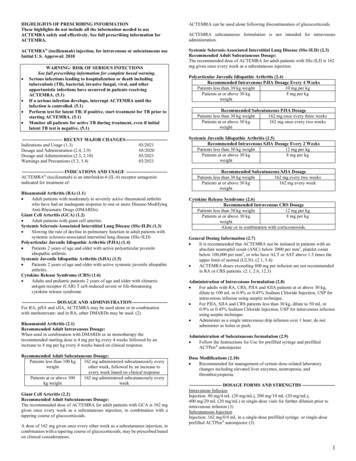
Transcription
HIGHLIGHTS OF PRESCRIBING INFORMATIONThese highlights do not include all the information needed to useACTEMRA safely and effectively. See full prescribing information forACTEMRA.ACTEMRA can be used alone following discontinuation of glucocorticoids.ACTEMRA (tocilizumab) injection, for intravenous or subcutaneous useInitial U.S. Approval: 2010Systemic Sclerosis-Associated Interstitial Lung Disease (SSc-ILD) (2.3)Recommended Adult Subcutaneous Dosage:The recommended dose of ACTEMRA for adult patients with SSc-ILD is 162mg given once every week as a subcutaneous injection. WARNING: RISK OF SERIOUS INFECTIONSSee full prescribing information for complete boxed warning.Serious infections leading to hospitalization or death includingtuberculosis (TB), bacterial, invasive fungal, viral, and otheropportunistic infections have occurred in patients receivingACTEMRA. (5.1)If a serious infection develops, interrupt ACTEMRA until theinfection is controlled. (5.1)Perform test for latent TB; if positive, start treatment for TB prior tostarting ACTEMRA. (5.1)Monitor all patients for active TB during treatment, even if initiallatent TB test is negative. (5.1)ACTEMRA subcutaneous formulation is not intended for intravenousadministration.Polyarticular Juvenile Idiopathic Arthritis (2.4)Recommended Intravenous PJIA Dosage Every 4 WeeksPatients less than 30 kg weight10 mg per kgPatients at or above 30 kg8 mg per kgweightRecommended Subcutaneous PJIA DosagePatients less than 30 kg weight162 mg once every three weeksPatients at or above 30 kg162 mg once every two weeksweight-------------------------- RECENT MAJOR CHANGES --------------------------Indications and Usage (1.3)03/2021Dosage and Administration (2.4, 2.9)05/2020Dosage and Administration (2.3, 2.10)03/2021Warnings and Precautions (5.3, 5.4)03/2021Systemic Juvenile Idiopathic Arthritis (2.5)Recommended Intravenous SJIA Dosage Every 2 WeeksPatients less than 30 kg weight12 mg per kgPatients at or above 30 kg8 mg per kgweight--------------------------- INDICATIONS AND USAGE --------------------------ACTEMRA (tocilizumab) is an interleukin-6 (IL-6) receptor antagonistindicated for treatment of:Recommended Subcutaneous SJIA DosagePatients less than 30 kg weight162 mg every two weeksPatients at or above 30 kg162 mg every weekweightRheumatoid Arthritis (RA) (1.1) Adult patients with moderately to severely active rheumatoid arthritiswho have had an inadequate response to one or more Disease-ModifyingAnti-Rheumatic Drugs (DMARDs).Giant Cell Arteritis (GCA) (1.2) Adult patients with giant cell arteritis.Systemic Sclerosis-Associated Interstitial Lung Disease (SSc-ILD) (1.3) Slowing the rate of decline in pulmonary function in adult patients withsystemic sclerosis-associated interstitial lung disease (SSc-ILD)Polyarticular Juvenile Idiopathic Arthritis (PJIA) (1.4) Patients 2 years of age and older with active polyarticular juvenileidiopathic arthritis.Systemic Juvenile Idiopathic Arthritis (SJIA) (1.5) Patients 2 years of age and older with active systemic juvenile idiopathicarthritis.Cytokine Release Syndrome (CRS) (1.6) Adults and pediatric patients 2 years of age and older with chimericantigen receptor (CAR) T cell-induced severe or life-threateningcytokine release syndrome.---------------------- DOSAGE AND ADMINISTRATION ----------------------For RA, pJIA and sJIA, ACTEMRA may be used alone or in combinationwith methotrexate: and in RA, other DMARDs may be used. (2)Rheumatoid Arthritis (2.1)Recommended Adult Intravenous Dosage:When used in combination with DMARDs or as monotherapy therecommended starting dose is 4 mg per kg every 4 weeks followed by anincrease to 8 mg per kg every 4 weeks based on clinical response.Recommended Adult Subcutaneous Dosage:Patients less than 100 kg162 mg administered subcutaneously everyweightother week, followed by an increase toevery week based on clinical responsePatients at or above 100162 mg administered subcutaneously everykg weightweekGiant Cell Arteritis (2.2)Recommended Adult Subcutaneous Dosage:The recommended dose of ACTEMRA for adult patients with GCA is 162 mggiven once every week as a subcutaneous injection, in combination with atapering course of glucocorticoids.A dose of 162 mg given once every other week as a subcutaneous injection, incombination with a tapering course of glucocorticoids, may be prescribed basedon clinical considerations.Cytokine Release Syndrome (2.6)Recommended Intravenous CRS DosagePatients less than 30 kg weight12 mg per kgPatients at or above 30 kg8 mg per kgweightAlone or in combination with corticosteroids.General Dosing Information (2.7) It is recommended that ACTEMRA not be initiated in patients with anabsolute neutrophil count (ANC) below 2000 per mm3, platelet countbelow 100,000 per mm3, or who have ALT or AST above 1.5 times theupper limit of normal (ULN). (2.1, 5.4) ACTEMRA doses exceeding 800 mg per infusion are not recommendedin RA or CRS patients. (2.1, 2.6, 12.3)Administration of Intravenous formulation (2.8) For adults with RA, CRS, PJIA and SJIA patients at or above 30 kg,dilute to 100 mL in 0.9% or 0.45% Sodium Chloride Injection, USP forintravenous infusion using aseptic technique. For PJIA, SJIA and CRS patients less than 30 kg, dilute to 50 mL in0.9% or 0.45% Sodium Chloride Injection, USP for intravenous infusionusing aseptic technique. Administer as a single intravenous drip infusion over 1 hour; do notadminister as bolus or push.Administration of Subcutaneous formulation (2.9) Follow the Instructions for Use for prefilled syringe and prefilledACTPen autoinjectorDose Modifications (2.10) Recommended for management of certain dose-related laboratorychanges including elevated liver enzymes, neutropenia, andthrombocytopenia.--------------------- DOSAGE FORMS AND STRENGTHS --------------------Intravenous InfusionInjection: 80 mg/4 mL (20 mg/mL), 200 mg/10 mL (20 mg/mL),400 mg/20 mL (20 mg/mL) in single-dose vials for further dilution prior tointravenous infusion (3)Subcutaneous InjectionInjection: 162 mg/0.9 mL in a single-dose prefilled syringe or single-doseprefilled ACTPen autoinjector (3)1
------------------------------ CONTRAINDICATIONS ----------------------------- ACTEMRA is contraindicated in patients with known hypersensitivityto ACTEMRA. (4)------------------------------ ADVERSE REACTIONS -----------------------------Most common adverse reactions (incidence of at least 5%): upper respiratorytract infections, nasopharyngitis, headache, hypertension, increased ALT,injection site reactions. (6)----------------------- WARNINGS AND PRECAUTIONS ---------------------- Serious Infections – do not administer ACTEMRA during an activeTo report SUSPECTED ADVERSE REACTIONS, contact Genentech atinfection, including localized infections. If a serious infection develops,1-888-835-2555 or FDA at 1-800-FDA-1088 or www.fda.gov/medwatchinterrupt ACTEMRA until the infection is controlled. (5.1) Gastrointestinal (GI) perforation—use with caution in patients who may----------------------- USE IN SPECIFIC POPULATIONS ----------------------be at increased risk. (5.2) Pregnancy: Based on animal data, may cause fetal harm. (8.1) Hepatotoxicity- Monitor patients for signs and symptoms of hepatic Lactation: Discontinue drug or nursing taking into considerationinjury. Modify or discontinue ACTEMRA if abnormal liver tests persistimportance of drug to mother. (8.2)or worsen or if clinical signs and symptoms of liver disease develop.(2.10, 5.3)See 17 for PATIENT COUNSELING INFORMATION and Medication Laboratory monitoring—recommended due to potential consequences ofGuidetreatment-related changes in neutrophils, platelets, lipids, and liverRevised: 03/2021function tests. (2.10, 5.4) Hypersensitivity reactions, including anaphylaxis and death haveoccurred. (5.6) Live vaccines—Avoid use with ACTEMRA. (5.9, 7.3)2
FULL PRESCRIBING INFORMATION: CONTENTS*WARNING: RISK OF SERIOUS INFECTIONS16.6 Clinical Trials Experience in Polyarticular Juvenile IdiopathicArthritis Patients Treated With Subcutaneous ACTEMRA(ACTEMRA-SC)6.7 Clinical Trials Experience in Systemic Juvenile Idiopathic ArthritisPatients Treated with Intravenous ACTEMRA (ACTEMRA-IV)6.8 Clinical Trials Experience in Systemic Juvenile Idiopathic ArthritisPatients Treated with Subcutaneous ACTEMRA (ACTEMRA-SC)6.9 Clinical Trials Experience in Patients with Cytokine ReleaseSyndrome Treated with Intravenous ACTEMRA (ACTEMRA-IV)6.10 Postmarketing ExperienceDRUG INTERACTIONS7.1 Concomitant Drugs for Treatment of Adult Indications7.2 Interactions with CYP450 Substrates7.3 Live VaccinesUSE IN SPECIFIC POPULATIONS8.1 Pregnancy8.2 Lactation8.4 Pediatric Use8.5 Geriatric Use8.6 Hepatic Impairment8.7 Renal ImpairmentDRUG ABUSE AND DEPENDENCEOVERDOSAGEDESCRIPTIONCLINICAL PHARMACOLOGY12.1 Mechanism of Action12.2 Pharmacodynamics12.3 PharmacokineticsNONCLINICAL TOXICOLOGY13.1 Carcinogenesis, Mutagenesis, Impairment of FertilityCLINICAL STUDIES14.1 Rheumatoid Arthritis – Intravenous Administration14.2 Rheumatoid Arthritis – Subcutaneous Administration14.3 Giant Cell Arteritis – Subcutaneous Administration14.4 Systemic Sclerosis-Associated Interstitial Lung Disease –Subcutaneous Administration14.5 Polyarticular Juvenile Idiopathic Arthritis – IntravenousAdministration14.6 Polyarticular Juvenile Idiopathic Arthritis – SubcutaneousAdministration14.7 Systemic Juvenile Idiopathic Arthritis – Intravenous Administration14.8 Systemic Juvenile Idiopathic Arthritis – SubcutaneousAdministration14.9 Cytokine Release Syndrome – Intravenous AdministrationHOW SUPPLIED/STORAGE AND HANDLINGPATIENT COUNSELING INFORMATIONINDICATIONS AND USAGE1.1 Rheumatoid Arthritis (RA)1.2 Giant Cell Arteritis (GCA)1.3 Systemic Sclerosis-Associated Interstitial Lung Disease (SSc-ILD)1.4 Polyarticular Juvenile Idiopathic Arthritis (PJIA)1.5 Systemic Juvenile Idiopathic Arthritis (SJIA)71.6 Cytokine Release Syndrome (CRS)2 DOSAGE AND ADMINISTRATION2.1 Rheumatoid Arthritis2.2 Giant Cell Arteritis82.3 Systemic Sclerosis-Associated Interstitial Lung Disease2.4 Polyarticular Juvenile Idiopathic Arthritis2.5 Systemic Juvenile Idiopathic Arthritis2.6 Cytokine Release Syndrome2.7 General Considerations for Administration2.8 Preparation and Administration Instructions for IntravenousInfusion92.9 Preparation and Administration Instructions for Subcutaneous10Injection112.10 Dosage Modifications due to Serious Infections or Laboratory12Abnormalities3 DOSAGE FORMS AND STRENGTHS4 CONTRAINDICATIONS5 WARNINGS AND PRECAUTIONS135.1 Serious Infections5.2 Gastrointestinal Perforations145.3 Hepatotoxicity5.4 Laboratory Parameters5.5 Immunosuppression5.6 Hypersensitivity Reactions, Including Anaphylaxis5.7 Demyelinating Disorders5.8 Active Hepatic Disease and Hepatic Impairment5.9 Vaccinations6 ADVERSE REACTIONS6.1 Clinical Trials Experience in Rheumatoid Arthritis Patients Treatedwith Intravenous ACTEMRA (ACTEMRA-IV)6.2 Clinical Trials Experience in Rheumatoid Arthritis Patients Treatedwith Subcutaneous ACTEMRA (ACTEMRA-SC)6.3 Clinical Trials Experience in Giant Cell Arteritis Patients Treatedwith Subcutaneous ACTEMRA (ACTEMRA-SC)166.4 Clinical Trials Experience in Systemic Sclerosis-Associated17Interstitial Lung Disease Patients Treated with SubcutaneousACTEMRA (ACTEMRA-SC)*Sections or subsections omitted from the full prescribing information are not6.5 Clinical Trials Experience in Polyarticular Juvenile Idiopathiclisted.Arthritis Patients Treated With Intravenous ACTEMRA(ACTEMRA-IV)FULL PRESCRIBING INFORMATIONWARNING: RISK OF SERIOUS INFECTIONSPatients treated with ACTEMRA are at increased risk for developing serious infections that may lead tohospitalization or death [see Warnings and Precautions (5.1), Adverse Reactions (6.1)]. Most patients whodeveloped these infections were taking concomitant immunosuppressants such as methotrexate orcorticosteroids.If a serious infection develops, interrupt ACTEMRA until the infection is controlled.Reported infections include: Active tuberculosis, which may present with pulmonary or extrapulmonary disease. Patients shouldbe tested for latent tuberculosis before ACTEMRA use and during therapy. Treatment for latentinfection should be initiated prior to ACTEMRA use. Invasive fungal infections, including candidiasis, aspergillosis, and pneumocystis. Patients withinvasive fungal infections may present with disseminated, rather than localized, disease.3
Bacterial, viral and other infections due to opportunistic pathogens.The risks and benefits of treatment with ACTEMRA should be carefully considered prior to initiatingtherapy in patients with chronic or recurrent infection.Patients should be closely monitored for the development of signs and symptoms of infection during and aftertreatment with ACTEMRA, including the possible development of tuberculosis in patients who testednegative for latent tuberculosis infection prior to initiating therapy [see Warnings and Precautions (5.1)].1INDICATIONS AND USAGE1.1 Rheumatoid Arthritis (RA)ACTEMRA (tocilizumab) is indicated for the treatment of adult patients with moderately to severely activerheumatoid arthritis who have had an inadequate response to one or more Disease-Modifying Anti-RheumaticDrugs (DMARDs).1.2 Giant Cell Arteritis (GCA)ACTEMRA (tocilizumab) is indicated for the treatment of giant cell arteritis (GCA) in adult patients.1.3 Systemic Sclerosis-Associated Interstitial Lung Disease (SSc-ILD)ACTEMRA (tocilizumab) is indicated for slowing the rate of decline in pulmonary function in adult patientswith systemic sclerosis-associated interstitial lung disease.1.4 Polyarticular Juvenile Idiopathic Arthritis (PJIA)ACTEMRA (tocilizumab) is indicated for the treatment of active polyarticular juvenile idiopathic arthritis inpatients 2 years of age and older.1.5 Systemic Juvenile Idiopathic Arthritis (SJIA)ACTEMRA (tocilizumab) is indicated for the treatment of active systemic juvenile idiopathic arthritis in patients2 years of age and older.1.6 Cytokine Release Syndrome (CRS)ACTEMRA (tocilizumab) is indicated for the treatment of chimeric antigen receptor (CAR) T cell-inducedsevere or life-threatening cytokine release syndrome in adults and pediatric patients 2 years of age and older.2DOSAGE AND ADMINISTRATION2.1 Rheumatoid ArthritisACTEMRA may be used as monotherapy or concomitantly with methotrexate or other non-biologic DMARDsas an intravenous infusion or as a subcutaneous injection.Recommended Intravenous Dosage Regimen:The recommended dosage of ACTEMRA for adult patients given as a 60-minute single intravenous drip infusion is4 mg per kg every 4 weeks followed by an increase to 8 mg per kg every 4 weeks based on clinical response. Reduction of dose from 8 mg per kg to 4 mg per kg is recommended for management of certain dose-relatedlaboratory changes including elevated liver enzymes, neutropenia, and thrombocytopenia [see Dosage andAdministration (2.10), Warnings and Precautions (5.3, 5.4), and Adverse Reactions (6.1)].Doses exceeding 800 mg per infusion are not recommended in RA patients [see Clinical Pharmacology(12.3)].Recommended Subcutaneous Dosage Regimen:Patients less than 100 kg weight162 mg administered subcutaneously everyother week, followed by an increase to everyweek based on clinical response4
Patients at or above 100 kg weight162 mg administered subcutaneously everyweekWhen transitioning from ACTEMRA intravenous therapy to subcutaneous administration administer the firstsubcutaneous dose instead of the next scheduled intravenous dose.Interruption of dose or reduction in frequency of administration of subcutaneous dose from every week to everyother week dosing is recommended for management of certain dose-related laboratory changes including elevatedliver enzymes, neutropenia, and thrombocytopenia [see Dosage and Administration (2.10), Warnings andPrecautions (5.3, 5.4), and Adverse Reactions (6.2)].2.2 Giant Cell ArteritisThe recommended dose of ACTEMRA for adult patients with GCA is 162 mg given once every week as asubcutaneous injection in combination with a tapering course of glucocorticoids.A dose of 162 mg given once every other week as a subcutaneous injection in combination with a tapering courseof glucocorticoids may be prescribed based on clinical considerations.ACTEMRA can be used alone following discontinuation of glucocorticoids. Interruption of dosing may be needed for management of dose-related laboratory abnormalities includingelevated liver enzymes, neutropenia, and thrombocytopenia [see Dosage and Administration (2.10)].Intravenous administration is not approved for GCA.2.3Systemic Sclerosis-Associated Interstitial Lung DiseaseThe recommended dose of ACTEMRA for adult patients with SSc-ILD is 162 mg given once every week as asubcutaneous injection. Interruption of dosing may be needed for management of dose-related laboratory abnormalities includingelevated liver enzymes, neutropenia, and thrombocytopenia [see Dosage and Administration (2.10)].Subcutaneous administration with the prefilled ACTPen autoinjector has not been studied in SSc-ILD.Intravenous administration is not approved for SSc-ILD.2.4 Polyarticular Juvenile Idiopathic ArthritisACTEMRA may be used as an intravenous infusion or as a subcutaneous injection alone or in combination withmethotrexate. Do not change dose based solely on a single visit body weight measurement, as weight mayfluctuate.Recommended Intravenous Dosage Regimen:The recommended dosage of ACTEMRA for PJIA patients given once every 4 weeks as a 60-minute singleintravenous drip infusion is:Recommended Intravenous PJIA Dosage Every 4 WeeksPatients less than 30 kg weight10 mg per kgPatients at or above 30 kg weight8 mg per kgRecommended Subcutaneous Dosage Regimen:Recommended Subcutaneous PJIA DosagePatients less than 30 kg weight162 mg once every 3 weeksPatients at or above 30 kg weight162 mg once every 2 weeksWhen transitioning from ACTEMRA intravenous therapy to subcutaneous administration, administer the firstsubcutaneous dose instead of the next scheduled intravenous dose.5
Interruption of dosing may be needed for management of dose-related laboratory abnormalities including elevatedliver enzymes, neutropenia, and thrombocytopenia [see Dosage and Administration (2.10].2.5 Systemic Juvenile Idiopathic ArthritisACTEMRA may be used as an intravenous infusion or as a subcutaneous injection alone or in combination withmethotrexate. Do not change a dose based solely on a single visit body weight measurement, as weight mayfluctuate.Recommended Intravenous Dosage Regimen:The recommended dose of ACTEMRA for SJIA patients given once every 2 weeks as a 60-minute singleintravenous drip infusion is:Recommended Intravenous SJIA Dosage Every 2 WeeksPatients less than 30 kg weight12 mg per kgPatients at or above 30 kg weight8 mg per kgRecommended Subcutaneous Dosage Regimen:Recommended Subcutaneous SJIA DosagePatients less than 30 kg weight162 mg once every two weeksPatients at or above 30 kg weight162 mg once every weekWhen transitioning from ACTEMRA intravenous therapy to subcutaneous administration, administer the firstsubcutaneous dose when the next scheduled intravenous dose is due.Interruption of dosing may be needed for management of dose-related laboratory abnormalities including elevatedliver enzymes, neutropenia, and thrombocytopenia [see Dosage and Administration (2.10)].2.6 Cytokine Release Syndrome (CRS)Use only the intravenous route for treatment of CRS. The recommended dose of ACTEMRA for treatment ofCRS given as a 60-minute intravenous infusion is:Recommended Intravenous CRS DosagePatients less than 30 kg weight12 mg per kgPatients at or above 30 kg weight8 mg per kgAlone or in combination with corticosteroids If no clinical improvement in the signs and symptoms of CRS occurs after the first dose, up to 3 additionaldoses of ACTEMRA may be administered. The interval between consecutive doses should be at least8 hours. Doses exceeding 800 mg per infusion
4 Bacterial, viral and other infections due to opportunistic pathogens. The risks and benefits of treatment with ACTEMRA should be carefully considered prior to initiating
